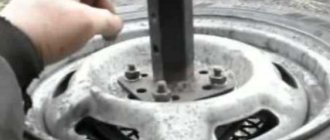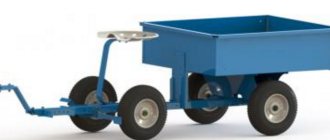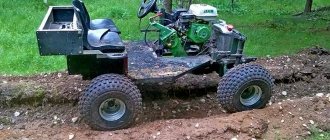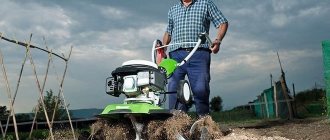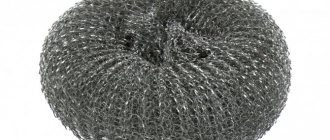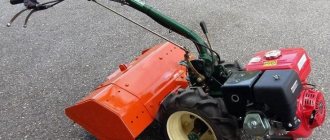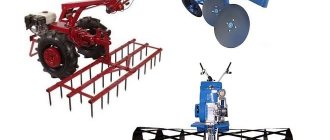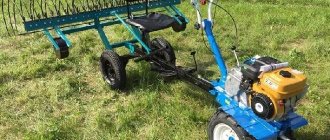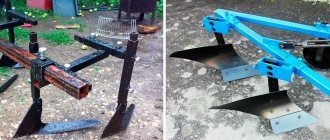Using various weights for walk-behind tractors, owners of land plots can significantly increase the functionality and expand the range of use of these machines. Walk-behind tractors and walk-behind cultivators are indispensable assistants when carrying out excavation work on large and small areas and transporting goods over short distances. With their help, less time and effort is spent on soil cultivation. However, in some cases, even the most modern and expensive equipment, such as the domestic Neva walk-behind tractor, cannot cope with certain tasks. When raising virgin soil, working on slopes and in damp soil, the wheels of the unit slip, since it does not have enough of its own weight for reliable traction. In order to weigh down the car, various factory-made and home-made weights are used.
Since an agricultural equipment store may be located at a considerable distance from a summer cottage, many property owners make weighting devices themselves. Sometimes homemade weights for a walk-behind tractor are installed in order to balance its center of gravity. This modification is required when performing planting work or using an adapter. Let's look at how you can make weights for a walk-behind tractor with your own hands, using the tools and equipment that you have at hand.
How to weight a cultivator with your own hands
Owners of low-power cultivators equipped with an electric motor (for example, Garden M 750 ET, PATRIOT ELEKTRA 1000 or HYUNDAI T 1810E soil tillers) are faced with the problem that when passing through an area with hard or medium-density soil, the mini-cultivator bounces and cannot cope with the task. task.
To make the manual plowing unit heavier, craftsmen install foam blocks or a 5-liter bottle filled with sand on top of the body. Such an upgrade will help the mini-cultivator to effectively cultivate a small summer cottage, but it will become more difficult for the operator to control it.
What else do you need to know?
Motoblocks "Plowman" can be operated in any weather conditions that are typical for central Russia. Air humidity and precipitation do not play a special role. When making a steel frame, reinforced corners are used. They are treated with a substance that inhibits corrosion. Each seam is evaluated on special production equipment, which allows us to increase the share of quality products to 100%.
The developers were able to create an excellent cooling system. It blocks overheating of the pistons even at extremely high air temperatures. The transmission housing is strong enough that the gearbox does not suffer during normal use. The well-thought-out wheel geometry reduces the complexity of cleaning them. The design of the walk-behind tractor also includes a power take-off shaft, which significantly increases the functionality of the device.
With the help of a block, it is possible to plow up virgin soil with a single-furrow plow. If you need to process black soil or light sand, it is recommended to use trailers with 2 or more shares. Both disc and switch hillers are compatible with the Plowman 820. If you use rotary mowers, you can mow about 1 hectare per day. Together with this walk-behind tractor, it is recommended to use rotary-type snowblowers.
By attaching a rake to the “Plowman”, you can clear the area of the site from small debris and old grass. This walk-behind tractor also allows you to connect a pump with a capacity of 10 liters per second. It will also serve as a good drive for electric generators producing up to 5 kW. Some owners make the “Plowman” a drive for various crushers and handicraft machines. It is also compatible with single-axis adapters from a number of manufacturers.
See the video below for more information about the Plowman walk-behind tractors.
How to weight a walk-behind tractor with your own hands
Installing homemade weighting materials will help eliminate slippage and increase the efficiency of light and medium-sized walk-behind tractors (such as Neva MB-2 and MB-1, Patriot, Oka, Salyut and others).
To figure out how to weight a walk-behind tractor correctly, you need to understand that there are three ways to achieve a specific task:
- secure loads on the body of agricultural machinery;
- make weights for wheels or lugs;
- increase the weight of the attachment (plow, hiller, snow shovel, etc.) to improve penetration.
Efficiency of the device
Any walk-behind tractor can be equipped with one of two types of wheels:
- rubber, that is, pneumatic.
- metal.
But regardless of their type, the machine must be able to cultivate the ground at a sufficient depth. It’s a different matter when it comes to practice: it turns out that the weight of the walk-behind tractor itself is not enough to properly cultivate the soil. The wheels may begin to slip, which is the first sign that the device is underweight. There is a way out of this situation, which is called very simply: weights for walk-behind tractor .
List of tools and equipment
As a rule, each summer cottage has a sufficient number of metal products and a set of devices for carrying out a wide range of work.
In order to make wheel weights for a walk-behind tractor with your own hands, you will need the following tools and materials:
- roulette;
- welding machine;
- building level;
- grinder with discs for cutting and grinding metal;
- electric drill with a set of drills;
- a small steel or aluminum barrel with a screw-on lid;
- barbell plates weighing 5, 10, 20 kg;
- steel corner 30-50 mm;
- paint brush;
- car paint.
Weight the walk-behind tractor so that you can always quickly dismantle attached attachments. They will not be required when mowing grass and performing other work that does not require strong adhesion to the ground. In such cases, excess cargo will interfere and lead to excessive fuel consumption.
Specific examples
Wheels of the Shtenli G-192 walk-behind tractor are often equipped with weights.
This is a large-sized device with the help of which tillage becomes a breeze. But there are certain operating rules.
Shtenli G-192 wheels should not be overloaded by more than 100 kg, as such overload can negatively affect engine performance. Its operating time is approximately 60-70 minutes. After this time has elapsed, turn it off and wait until the engine cools down. Then you can get back to work. It should be noted that the greater the weight, the less time the walk-behind tractor will work, and it will have to be cooled more. Maintenance schedules must be followed. That is, change the oil, spark plugs and filters at regular intervals. Carry out a full technical inspection once a year. To protect your eardrums from excessive noise, use earplugs, and gloves will help you against vibration. Remember to store the walk-behind tractor in a warm, dry place
This is very important, since moisture is the enemy of any equipment and can ruin the operation of the device.
Some technical parameters of this walk-behind tractor:
- there is support for additional devices;
- type of connection to the power take-off shaft pulley (belt);
- heavy cultivator;
- reverse rotation of cutters;
- cultivation depth 30 cm;
- tillage width 90 cm;
- electric starter is present;
- diesel engine, four-stroke, 2 cylinders;
- engine capacity 12 l. With.;
- disc clutch;
- gear shift lever type: manual;
- auto reverse is present;
- number of gears 6 forward, 2 reverse;
- gear regulator type;
- wheel dimensions – height 13, width – 7.50 cm;
- pneumatic wheels;
- tank volume 6 l;
- weight 5 kg.
Let's consider an example of weighting the MZR-820 walk-behind tractor.
This type of walk-behind tractor is already somewhat smaller than the previous one, but this does not mean that it is less effective. With its help, you can plow, remove snow and transport small loads if you make the wheels heavier.
Now let's talk about some operating rules.
- First, we need to say that it is better not to overload it, since it is small in size. The permissible wheel overload can be no more than 50 kg, and the total overload should be no more than 100 kg.
- When starting up for the first time, make sure that the walk-behind tractor is fully fueled and filled with oil.
- After you have broken in the oil, you need to drain it, and the next time you use the device, fill it with new fresh oil.
- Make sure that small stones, grass and branches do not get into the cutters. They can damage the knives.
- Turn on the device on a flat surface.
- Once a year, undergo a full technical inspection in special places.
- Store the walk-behind tractor in a dry, warm place.
Here are some of its parameters:
- fuel tank volume 3.6 l;
- warranty period 3 years;
- engine type: gasoline;
- power 180 kW / 8 l. With.;
- belt clutch;
- chain regulator;
- gear lever, number of speeds 2-1;
- working width 100 cm;
- grip depth 30 cm;
- engine volume 210 cm3;
- turning on by hand;
- weight 90 kg;
- cutter configuration, 4-10 wheels, opener;
- a power take-off shaft is present.
To learn how to make a weighting agent for a walk-behind tractor with your own hands, see below.
Do-it-yourself load on the wheels of a walk-behind tractor
The most common way to make a car heavier is to install additional weights on the wheels. The rims, axle and hub are strong enough to support up to 50kg of added weight. You can make weights for the walk-behind tractor Neva, Ugra, Cascade, Rusich, Nadezhda, Forza, Salyut, Krot in various ways.
The first method is to make a load from hollow steel barrels.
This is the simplest and most affordable option that does not require significant financial costs.
The work is carried out in the following sequence:
- The metal barrel is cut into 3 parts by a grinder (the bottom and top should be 10-15 cm high - depending on the size of the walk-behind tractor).
- The bottom and top parts are welded at the cut site. The seam can be reinforced with a strip of metal.
- 4-6 through holes for bolts are drilled in the workpiece, and if necessary, they are reinforced with steel washers.
- Hollow tanks are secured to wheel rims using long bolts and nuts.
- Sand and granite chips or other bulk material are poured inside the nozzles. Water is added to increase its density.
- The lid is screwed on.
This weighted unit can be used in the most extreme conditions. When the additional weight is no longer needed, it can be quickly removed, emptied and stored. It is advisable to always have pads with your walk-behind tractor in order to quickly make it heavier when the need arises.
The second method is the manufacture of removable steel weights. To do this, you will need a hexagonal iron rod, the size of which coincides with the hole in the axis of the unit’s chassis. Additionally, you need to have 2 20-kilogram weight plates.
Subsequent work consists of the following stages:
- 2 pieces of 5-6 cm long are cut from the profile.
- Pieces of the profile are welded to the discs in the place of the hole for the neck.
- Through holes for cotter pins are made in the axis of the unit and in the profile.
- The made weights cling to the walk-behind tractor and are secured with cotter pins.
If there is a need to further increase the weight of the wheel, you can weld 10-kilogram barbells to the linings. To give the wheel an aesthetic appearance, old clutch baskets from VAZ are welded to the weights. Paint is applied over the basket, the color of which suits the owner most.
The third way to weight the wheels is to make an additional load from reinforced concrete. These loads are made in this way:
- A flask is made from sand or gypsum, its walls and bottom are strengthened with cement mortar or liquid glass.
- A three-dimensional frame is made from a sheet of steel and reinforcement, the center of which is a solid hexagon with a pre-drilled hole for a cotter pin.
- Heavy concrete is made using fine granite crushed stone and lead filler.
- The solution is poured into the mold, thoroughly compacted and leveled.
- After the concrete gains strength, its surface is treated with impregnation and painted.
To add additional weight to the concrete attachments, it is recommended to leave the embeds with threads.
In addition to the listed manufacturing methods, loads on a walk-behind tractor are made from:
- cement balancers from a washing machine;
- lead, by casting the desired shape;
- steel sheet and sand.
It is better to do the last option not with the original motoblock pneumatic wheels, but to take a couple of automobile ones (for example, from a Zhiguli) and modernize them. To do this, you need to weld hubs from old motor-cultivator wheels to them, and attach steel sheets to the sidewalls by welding. Sand is poured into the resulting cavity or a cement mixture is poured.
Specific examples
Wheels of the Shtenli G-192 walk-behind tractor are often equipped with weights.
This is a large-sized device with the help of which tillage becomes a breeze. But there are certain operating rules.
Shtenli G-192 wheels should not be overloaded by more than 100 kg, as such overload can negatively affect engine performance. Its operating time is approximately 60-70 minutes. After this time has elapsed, turn it off and wait until the engine cools down. Then you can get back to work. It should be noted that the greater the weight, the less time the walk-behind tractor will work, and it will have to be cooled more. Maintenance schedules must be followed. That is, change the oil, spark plugs and filters at regular intervals. Carry out a full technical inspection once a year. To protect your eardrums from excessive noise, use earplugs, and gloves will help you against vibration. Remember to store the walk-behind tractor in a warm, dry place
This is very important, since moisture is the enemy of any equipment and can ruin the operation of the device.
Some technical parameters of this walk-behind tractor:
- there is support for additional devices;
- type of connection to the power take-off shaft pulley (belt);
- heavy cultivator;
- reverse rotation of cutters;
- cultivation depth 30 cm;
- tillage width 90 cm;
- electric starter is present;
- diesel engine, four-stroke, 2 cylinders;
- engine capacity 12 l. With.;
- disc clutch;
- gear shift lever type: manual;
- auto reverse is present;
- number of gears 6 forward, 2 reverse;
- gear regulator type;
- wheel dimensions – height 13, width – 7.50 cm;
- pneumatic wheels;
- tank volume 6 l;
- weight 5 kg.
Let's consider an example of weighting the MZR-820 walk-behind tractor.
This type of walk-behind tractor is already somewhat smaller than the previous one, but this does not mean that it is less effective. With its help, you can plow, remove snow and transport small loads if you make the wheels heavier.
Now let's talk about some operating rules.
- First, we need to say that it is better not to overload it, since it is small in size. The permissible wheel overload can be no more than 50 kg, and the total overload should be no more than 100 kg.
- When starting up for the first time, make sure that the walk-behind tractor is fully fueled and filled with oil.
- After you have broken in the oil, you need to drain it, and the next time you use the device, fill it with new fresh oil.
- Make sure that small stones, grass and branches do not get into the cutters. They can damage the knives.
- Turn on the device on a flat surface.
- Once a year, undergo a full technical inspection in special places.
- Store the walk-behind tractor in a dry, warm place.
How to weight the lugs for a walk-behind tractor
To perform work on viscous clay or loamy soil, metal lugs are installed on the walk-behind tractor instead of wheels. In order to maintain the required plowing depth, it is necessary to make the machine heavier by hanging weights on the chassis of the unit.
If factory weights are used as weights and their weight is not enough, auxiliary ones can be used together with them. Make weights yourself:
- modernize lugs by welding metal plates;
- make concrete weights (the procedure here is similar to the method of making weights for pneumatic wheels, only as a mold for casting you need to take a pan with straight walls and a flat bottom, or a cut metal barrel of a suitable diameter);
- Flywheels from the engine of a VAZ 2106 Zhiguli car are well suited as a load, one for each wheel;
- select pulleys from agricultural machinery at disassembly that are suitable in diameter.
What is it for?
Weights are mainly used in walk-behind tractors, which are more intended for plowing the ground.
The weighting agent , by increasing the weight of the walk-behind tractor, normalizes the balance, thereby stabilizing its operation on an inclined plane and on hard ground. This increases work efficiency and simplifies work with agricultural machinery.
And walk-behind tractors are also great for transporting small loads on any road. It is because of this that they have become simply necessary in rural areas, where there are not always smooth, good roads. And the weighting material makes it possible to use agricultural machinery in this capacity.
Weighting the walk-behind tractor body
In some cases, the weight of the wheel weights is not enough. Since it is not recommended to overload the axle, weight is added to the unit body. This can be done in different ways. The best option is to attach the removable steel frame directly to the walk-behind tractor. The basis can be a frame, a gearbox or a niche for installing a battery.
The increase in body mass is carried out in the following sequence:
- Determination of the center of gravity of the unit. Creating a frame project.
- Welding bolts with a diameter of 12 mm and a length of at least 10 cm to the gearshift housing and to the steering wheel bracket of the walk-behind tractor.
- Welding a frame from a corner. Making mounting holes for bolts in it.
- Fitting the frame to the frame. Drilling holes in it that correspond in location to the holes on the frame.
- Cleaning the frame from dirt and rust. Painting the product and fixing it to the frame.
- Making cargo to fit the size of the frame. You can find the necessary parts at a scrap metal collection point, where the material will be immediately cut into fragments of the required size.
The weights are secured to the walk-behind tractor using welding or bolted connections. The second option takes longer to implement, but is more practical in the long term. The need to remove additional weight arises when transporting the unit or performing light work, when excess pressure on the ground is contraindicated.
Features of use
The load for the walk-behind tractor increases the weight of the equipment, which increases the traction force. Thus, the unit can cultivate the soil more efficiently and deeply, even with heavy soil types. Weights also improve the quality of work on hard soils and sloped areas.
With the help of this additional equipment, the adhesion of walk-behind tractors to the soil is improved, and a balance of all mounted elements is achieved. It will be easier for the owner to operate the equipment and cultivate the land more efficiently.
Walk-behind tractor weights for lugs
These devices are needed if the traction force needs to be increased. Thanks to this, the equipment will not slip under high loads.
When choosing weights for the wheels of a walk-behind tractor or its body, you should pay attention to the following characteristics:
- width of additional equipment;
- diameter of structures (for mounting on wheels);
- weight of cargo (starts from 20 kg and on average can increase the traction force of a walk-behind tractor by 20%).
How to make a counterweight for a walk-behind tractor with your own hands
A counterweight is a front weight for a walk-behind tractor, which is hung on the front bumper pipe and helps increase the efficiency of plowing hard soil and virgin soil. It can also be used to shift the center of gravity of the cultivator, thereby increasing stability during operation.
To make a counterweight for a walk-behind tractor with your own hands, you will need heavy improvised objects, fasteners and a little ingenuity. Let's consider several homemade options:
- five-liter bottles filled with water or sand, which are hung by the handle and secured with a carabiner;
- a counterweight from a weight for scales (under it it is necessary to make a frame from a metal tape, which will be inserted into the guides from a steel profile welded from below to the frame of the agricultural unit);
- a weighting material cast from lead or cement in the form of a parallelepiped or cylinder, with pre-inserted “ears” made of a steel rod for hanging;
- several pancakes fastened together, to the outermost of which metal carbines are welded, serving as clamps for a homemade device.
Review of the Plowman MZR-820 walk-behind tractor. Specifications. Device. User manual
The Plowman-Yenisei MZR-820 walk-behind tractor is designed for operation on a site with a total area of up to 15 acres. In addition to agricultural applications, these machines are often used in municipal and landscape applications.
- This walk-behind tractor is equipped with an easy start system, which allows you to start the engine even at sub-zero temperatures.
- The MZR-820 plowman has a reinforced hitch that can withstand heavy loads and work with heavy attachments.
- The standard delivery set includes a set of cutters according to the scheme (3+1), which implies the ability to remove one pair from each side when processing narrow areas.
- During transport, the handle can be detached to reduce the space required by the machine.
The main difference from the Plowman MZR-800 model is the improved cast iron gearbox, which is able to withstand higher loads.
Specifications
| Power (hp) | 8 |
| engine's type | gasoline, 4-stroke |
| Working volume (cm³) | 208 |
| Fuel tank capacity (L) | 6.1 |
| Number of speeds (forward/reverse) | 2 forward / 1 reverse |
| Processing width(cm) | |
| Manual | |
| Processing depth (cm) | 32 |
| Clutch | Belt |
| Gearbox | Chain |
| Production | Russia |
| Weight, kg) | 105 |
| Warranty (months) | 12 |
Features of application
Before you start working on the Plowman walk-behind tractor, you should check the presence of fuel and oil, the correct connection of the attachments and the presence of visual damage.
Thanks to the universal hitch, you can use attachments from other Russian manufacturers: Neva, Oka and Cascade.
Adapter for walk-behind tractor Reversible plow Potato digger Walk-behind tractor blade
The most common attachments include cutters, plows, potato diggers, shovels and hillers.
Device
- The frame of the Plowman Yenisei MZR-820 walk-behind tractor is made of high-strength steel angle, with an anti-corrosion coating. All connections are manually checked at the factory.
- The gasoline engine supports operation not only on AI-92 fuel, but also AI-80. Air cooling prevents engine overheating during long-term operation. The engine is started using a manual starter.
- The gearbox of the Plowman MZR-820 walk-behind tractor has 3 stages (two for forward driving and one reverse).
User manual
The work of every new owner of the Plowman Yenisei MZR-820 walk-behind tractor should begin with familiarization with the operating instructions. This will help to properly assemble the device, run it in, operate it and maintain it. Also, the document indicates the main malfunctions and methods of repairing equipment.
Service
Motoblocks Plowman MZR-820 are high-quality domestically produced equipment; to maintain it in working condition, periodic maintenance should be performed, the schedule of which is described in the operating instructions.
The engine oil should be changed after 25 hours of operation; a lubricant classified as 10W-30 is best suited for this purpose.
Despite the fact that the gasoline engine of the Plowman Yenisei MZR-820 walk-behind tractor is capable of working with low-quality fuel, this is not recommended, since then, at best, the fuel filters will become clogged and the engine will stop working, and in extreme cases, you will have to disassemble and clean the carburetor .
work overview
Here is one of the video reviews of the operation of the Plowman MZR-820 petrol walk-behind tractor:
Owner reviews
Here are a few reviews from special forums regarding the experience of using this technique:
Alexei:
“My site is not standard. Not only is it with a bunch of stones that I have been trying to remove from the site for a long time, it is also located at an angle of 5 degrees. It is unbearably difficult to work with a shovel, so I bought an inexpensive Russian walk-behind tractor to relieve some of the tasks from myself. Mills properly. Digging potatoes is also easy, just set it out and go.
Pros: Low fuel consumption (only 1.5 liters per hour), easy to maintain.
Cons: You can feel the lack of weight on it, I compensate for this with weights"
Review of the Plowman MZR-820 walk-behind tractor. Specifications. Device. Operating instructions Link to main publication
Source: https://ProOgorod.com/selhoztekhnika/motobloki-kultivatory/motoblok-pahar-mzr-820-obzor
The most effective
When choosing appropriate devices, most often, the models that are most effective are taken into account. In practice, this is only true for specific types of attachments. Let's take a closer look at what types of appropriate equipment you should choose for the full cultivation of arable land:
- here, most often, multi-component milling devices are used, which allow processing the soil in different directions;
- you can give preference to a plow with a harrow, since this equipment can simultaneously plow, loosen and cultivate the soil;
- In addition, homemade devices should be highlighted, since they allow you to use everything you need in one mechanism;
- Collapsible multifunctional component cutters and plows with harrows are also in demand.
Each individual case has its own nuances in the appropriate selection of structural elements, but an integral part of any type are special weighting agents that serve to weight the structure when immersed in the ground.
As mentioned earlier, for uniform tillage of the soil with special attachments, appropriate weighting agents are used, which allows the mechanism used to remain at the required depth during movement. In this case, it is necessary to consider in more detail how to make the canopies used heavier, namely:
- for purchased equipment, special auxiliary weights can be used, which are hung together;
- if necessary, you can use hanging any heavy object for uniform plowing;
- in this case, it is possible to independently create a fairly heavy device that will loosen the soil evenly;
- Often, on manufactured versions, a corresponding center of gravity is specially provided, which is achieved by the presence of a certain design;
- weighting can be an additional adjustable insert that is present on the attachment.
There are quite a lot of options for increasing the mass of this device; here you just need to rationally use such weighting so that during operation the device does not fall deep enough into the ground. Otherwise, damage to the coupling mechanism or deformation of the tillage mechanism itself may occur.
Important. When working with such equipment, weather conditions should be taken into account, as well as the humidity and softness of the soil surface being treated.
In modern practice, there is no need to purchase such versions of structural elements, since it is possible to do everything necessary yourself.
As a rule, this will require certain materials, as well as some auxiliary tools for the manufacture of the corresponding mechanisms.
In this case, the procedure for making special homemade lugs is as follows:
- First of all, you will need to find the appropriate execution diagram, or make it yourself, taking into account the available assembly option.
- The next step will be to prepare everything necessary to install attachments on the motor cultivator.
- Next, you need to correctly calculate all the dimensions of the home-made lug for the cultivator to be completed.
- Additionally, it is necessary to decide on the option of coupling the homemade device and mechanized equipment.
Create your own lugs
- Subsequently, according to the prepared scheme, the necessary product for plowing the soil is manufactured.
- Here, a holding frame is produced separately, and in addition the device itself for cultivating the soil on a plot of land.
- Subsequently, the manufacture of the appropriate mechanism for coupling with the mount present on the walk-behind tractor is carried out.
- Next, a complete assembly of the entire mechanism is carried out from previously made individual structural elements and devices.
- Separately, weighting is arranged here, which can be done with the addition of weights determined by weight.
- Also, if necessary, you can use a specialized frame that will have the required weight and a shiftable center of gravity.
- After the structure is assembled, it will need to carry out its initial coupling with the mechanized cultivator.
- Additionally, a test run of the manufactured equipment is carried out, and, if necessary, adjustments are made.
When producing such technical equipment, the main thing in the work is the search or development of a diagram of a future version of the lug. Having the necessary drawing at your disposal will significantly reduce time costs, since the diagram contains a visual drawing of the device, and in addition, all the necessary dimensions are indicated.
It should be understood that in each individual case the dimensions of the structure are calculated based on the power of the installation, its size, and also the clutch option. In other words, it is not recommended to install a large lug on a walk-behind tractor with low weight and a weak motor, since such equipment can quickly damage the main mechanism due to excessive load.
Important. In practice, to independently carry out such equipment for tillage, any strong metal object can be used, including car wheels, whose service life has already expired.
Currently, the arrangement of attachments from these elements is quite widespread. This popularity is due to the following characteristic points:
- All car wheels have the necessary structural rigidity, as well as a suitable size and weight.
- Such devices are easy to find (often old devices are stored in the garages of almost all car owners).
- These variants of structural elements are quite easy to process, since they were initially made with an eye to possible repairs.
- The mechanisms already have the cuts and other openings necessary for fastening on their central plane.
- This type of device has a long service life with proper surface treatment.
Purpose of weights
Weights are used in the following cases:
- increased adhesion properties;
- improved weight distribution of the front and rear parts;
- making it easier to control the walk-behind tractor.
Weights are required when raising virgin soil, heavy soils, and working on slopes. With loads, less time and effort is spent on soil cultivation. In addition, their use makes it easier to transport goods on uneven rural roads by improving traction. You can purchase factory-made weights or make your own.
Weights improve the performance of the walk-behind tractor
Trailers
In farming and municipal services, there is often a need to transport small items over short distances. Plowman walk-behind tractors are perfectly adapted to work with all types of trailed devices.
The following can be attached to the unit:
Adapter. It is a compact cart with 1 axle and a seat. Used for agricultural work that lasts for a long time. The adapter eliminates the need for the operator to walk around the area and significantly reduces the load on his arms and back.
Cargo trailer. It has a bench for the driver and a voluminous body. Additional equipment can be installed on the drawbar. At the rear of the trailer there is a hitch for attaching rakes or harrows.
Combined trolley. Designed for planting or harvesting work. The presence of 2 seats allows one person to operate the walk-behind tractor, and the second to carry out various actions with attachments.
- Winter sleigh. Used for transporting various property in the snow. Made from durable polymer plastic.
In low gear, the walk-behind tractor can tow a trailer with a total weight of up to 500 kg. In this case, fuel consumption will not exceed 2 l/h.
For wheels
Disc weights for walk-behind tractor wheels are mounted on disks, as the name implies. They are thick metal rings with a hole in the middle. In cases of extreme necessity, they can also be made of concrete.
There are two ways to fix them. The easiest option is to weld it. It is suitable in cases where the equipment is constantly used on heavy soils, and there is no need to take it to the city at the end of the season. In this case, it is quite possible to install non-removable welded weights.
In other cases, it will be more convenient and practical to secure the loads with bolts. Weights are not needed when mowing grass, transporting loads on a flat road and other light work. Removable weights will ensure free weight adjustment depending on conditions and, if necessary, facilitate transportation of the walk-behind tractor.
It is important to remember that the total weight of wheel loads should not exceed 50 kg. Overloading will lead to increased wear on axles and hubs. It is recommended to check with the seller for the exact load level for a specific model.
STARTED TO LOOK FOR THE REASON WHY THE MOTOR-BLOCK STICKS
Plow?
EVERYTHING YOU NEED FOR THIS ARTICLE IS HERE >>>
The walk-behind tractor has enough power , even though it is petrol. Large 5/12 wheels provide excellent traction... There is only one reason left - the low weight of the walk-behind tractor (according to the passport - 125 kg).
I started looking for a way to fix this problem.
It turns out there are several methods.
- 1. Make a weighting mold in sand and pour molten lead into it (too difficult).
- 2. Make weights from a mixture of concrete and crushed stone (cheap, but short-lived).
- 3. Fill a container with sand and hang it on a walk-behind tractor (unreliable, inconvenient).
Owner reviews
On the forums you can read reviews about this model. Owners note its high functionality, power, performance and build quality.
Sergey, Smolensk region.
“I am the owner of the Plowman MZR-800 walk-behind tractor. I did less running-in than was given in the instructions, since my garden is small, I worked with the walk-behind tractor for several hours, taking breaks. Didn't load it too much. After these few hours it was already working as usual, nothing broke. I filled in new oil later. It was not possible to drain everything, but I consulted with the seller, he says there is a residue that cannot be drained, this is normal. The walk-behind tractor is fast and maneuverable. I used it to mow the grass; by the way, the Neva mower works great; I also plowed the land and cultivated the rows - I did everything without any problems. In my opinion, if you have large fields, such a machine will not suit you; you need something heavier and more powerful. And just right for small gardens.”
Nikita, Ryazan:
“Model: plowman MZR-820. I will write my review for the benefit of others. I like almost everything about the car, but I’m a picky buyer, so I found some cons. Overall, a good model for the price and I’m pleased with the choice of attachments! The manufacturer's hotline provides good information on all types of additional equipment.
Advantages: good assembly, easy to operate, works quickly, high-quality cutters. The manufacturer Mobile K has its own channel on YouTube. Request: upload more information, we are very interested in watching!
Disadvantages: I didn’t like the quality of the welded joint of the steering frame, and when clearing snow, the thrower sometimes slips; I would like it to move more slowly in first gear. But that’s how it is.”

